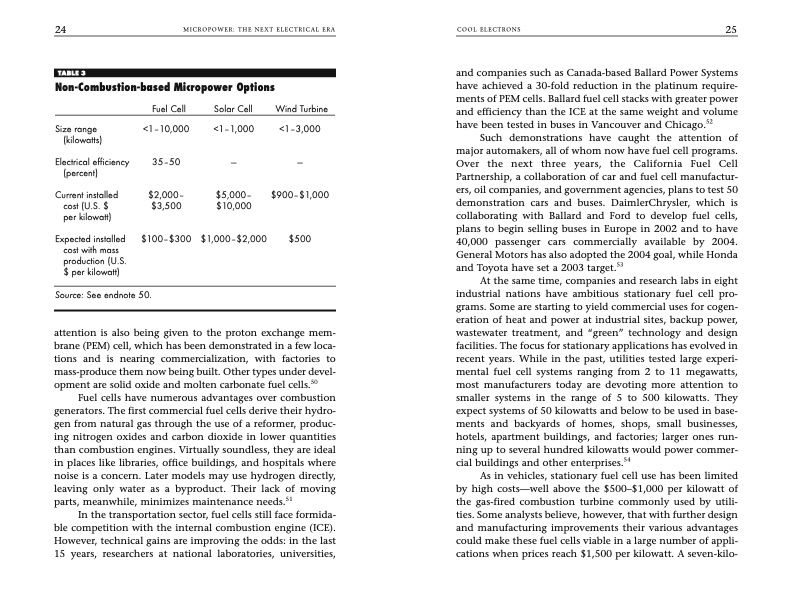
PDF Publication Title:
Text from PDF Page: 013
24 MICROPOWER: THE NEXT ELECTRICAL ERA COOL ELECTRONS 25 and companies such as Canada-based Ballard Power Systems have achieved a 30-fold reduction in the platinum require- ments of PEM cells. Ballard fuel cell stacks with greater power and efficiency than the ICE at the same weight and volume have been tested in buses in Vancouver and Chicago.52 Such demonstrations have caught the attention of major automakers, all of whom now have fuel cell programs. Over the next three years, the California Fuel Cell Partnership, a collaboration of car and fuel cell manufactur- ers, oil companies, and government agencies, plans to test 50 demonstration cars and buses. DaimlerChrysler, which is collaborating with Ballard and Ford to develop fuel cells, plans to begin selling buses in Europe in 2002 and to have 40,000 passenger cars commercially available by 2004. General Motors has also adopted the 2004 goal, while Honda and Toyota have set a 2003 target.53 At the same time, companies and research labs in eight industrial nations have ambitious stationary fuel cell pro- grams. Some are starting to yield commercial uses for cogen- eration of heat and power at industrial sites, backup power, wastewater treatment, and “green” technology and design facilities. The focus for stationary applications has evolved in recent years. While in the past, utilities tested large experi- mental fuel cell systems ranging from 2 to 11 megawatts, most manufacturers today are devoting more attention to smaller systems in the range of 5 to 500 kilowatts. They expect systems of 50 kilowatts and below to be used in base- ments and backyards of homes, shops, small businesses, hotels, apartment buildings, and factories; larger ones run- ning up to several hundred kilowatts would power commer- cial buildings and other enterprises.54 As in vehicles, stationary fuel cell use has been limited by high costs—well above the $500–$1,000 per kilowatt of the gas-fired combustion turbine commonly used by utili- ties. Some analysts believe, however, that with further design and manufacturing improvements their various advantages could make these fuel cells viable in a large number of appli- cations when prices reach $1,500 per kilowatt. A seven-kilo- TABLE 3 Non-Combustion-based Micropower Options Fuel Cell Solar Cell Wind Turbine Size range (kilowatts) Electrical efficiency (percent) Current installed cost (U.S. $ per kilowatt) Expected installed cost with mass production (U.S. $ per kilowatt) <1–10,000 35–50 $2,000– $3,500 $100–$300 <1–1,000 — — $5,000– $10,000 $900–$1,000 $1,000–$2,000 $500 <1–3,000 Source: See endnote 50. attention is also being given to the proton exchange mem- brane (PEM) cell, which has been demonstrated in a few loca- tions and is nearing commercialization, with factories to mass-produce them now being built. Other types under devel- opment are solid oxide and molten carbonate fuel cells.50 Fuel cells have numerous advantages over combustion generators. The first commercial fuel cells derive their hydro- gen from natural gas through the use of a reformer, produc- ing nitrogen oxides and carbon dioxide in lower quantities than combustion engines. Virtually soundless, they are ideal in places like libraries, office buildings, and hospitals where noise is a concern. Later models may use hydrogen directly, leaving only water as a byproduct. Their lack of moving parts, meanwhile, minimizes maintenance needs.51 In the transportation sector, fuel cells still face formida- ble competition with the internal combustion engine (ICE). However, technical gains are improving the odds: in the last 15 years, researchers at national laboratories, universities,PDF Image | Micropower: The Next Electrical Era

PDF Search Title:
Micropower: The Next Electrical EraOriginal File Name Searched:
EWP151.pdfDIY PDF Search: Google It | Yahoo | Bing
Capstone Turbine and Microturbine: Capstone microturbines used and new surplus for sale listing More Info
Consulting and Strategy Services: Need help with Capstone Turbine, sizing systems, applications, or renewable energy strategy, we are here to assist More Info
Container Lumber Dry Kiln: Since 1991 developing and innovating dry kilns using standard shipping containers More Info
Supercritical CO2 Lumber Dry Kiln: Compact fast drying in 3 days or less for small amounts of wood and lumber drying More Info
BitCoin Mining: Bitcoin Mining and Cryptocurrency... More Info
Publications: Capstone Turbine publications for microturbine and distributed energy More Info
FileMaker Software for Renewable Energy Developing database software for the renewable energy industry More Info
CO2 Gas to Liquids On-Demand Production Cart Developing a supercritical CO2 to alcohol on-demand production system (via Nafion reverse fuel cell) More Info
Stranded Gas for low cost power Bitcoin Mining Using stranded gas for generators may provide breakthrough low power costs for cryptocurrency miners. More Info
| CONTACT TEL: 608-238-6001 Email: greg@globalmicroturbine.com | RSS | AMP |